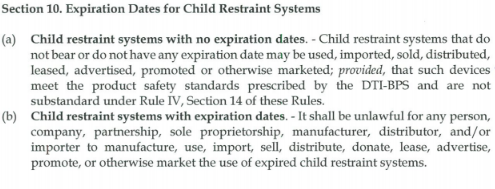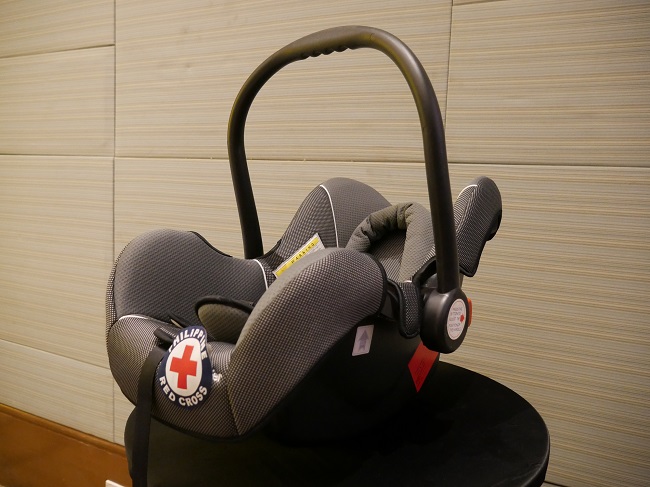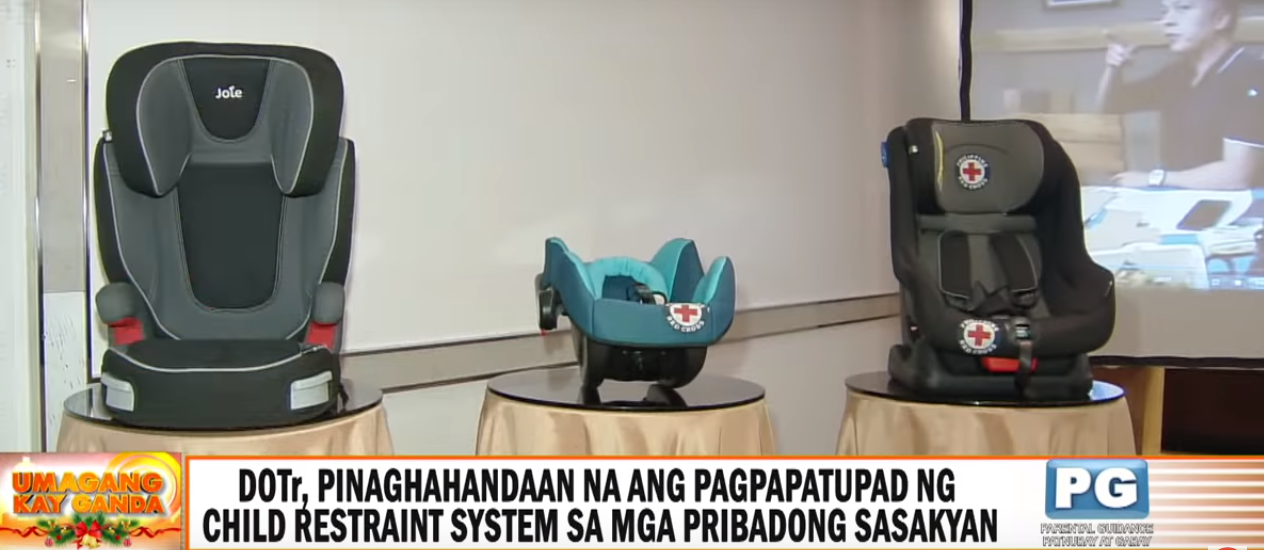It’s fairly easy to find out if milk in the refrigerator has gone bad.
One can sniff the milk or pour some into a glass to check. If it smells sour and is lumpy, it is time to get rid of it.
What about things that don’t have repulsive odors to indicate that they are no longer fit to consume or use? That’s what expiry dates are for, like in the case of medicines, which come with expiry dates to tell you that these may no longer be effective after a certain date.
But that is not exactly the case when it comes to child restraint systems (CRS): some have expiry dates while others don’t. But would an expired CRS compromise a child’s safety in a car?
Not necessarily.
“The science does not support setting a number of years for expiration dates because the quality (of car seats) differs,” said lawyer and policy adviser Evita Ricafort, who helped craft the implementing rules of the CRS law.
“They’re not like food products with a set number of years until they rot.”
CRS refers to a device capable of accommodating a child in a sitting or supine position. It is so designed as to diminish the risk of injury to the child, in the event of a collision or of an abrupt deceleration of the vehicle, by limiting his or her mobility.
The Child in Motor Vehicle Act or Republic Act 11229 was signed into law by President Rodrigo Duterte in February 2019, and its implementing rules were approved last December. Mandatory compliance with the law starts in February 2021.
The law mandates the use of car seats by infants and children 12 years and below while being transported in private motor vehicles to ensure their safety and welfare. It also states that only passengers who are 13 years old and older can use the front passenger seat. The law likewise punishes drivers who leave children in a car unaccompanied.
R.A. 11229 is one of the government’s responses to what the World Health Organization (WHO) calls the top killer of people aged 5 to 29 years old worldwide – road crashes.
The 2018 WHO Global Status Report on Road Safety also found that four in five road-traffic deaths around the world in 2016 occurred in middle-income countries like the Philippines.
The WHO said child restraints are “highly effective” in reducing injury and death to child occupants, with the greatest benefit for children under four years old.
Provisions on expiration date
The law’s implementing rules and regulations recognize that some car seats in the market have expiration dates, while some don’t.

Section 10 of the IRR of RA 11229
Section 10 of the IRR states that it would be unlawful to use, sell or distribute child safety seats that have expired. The same section, however, also says that car seats that do not bear any expiration date can be used, sold and distributed provided they meet the product standards set by the Department of Trade and Industry.
“There are child restraint systems that do have expiration dates and the law acknowledges that,” said Ricafort, from the public interest law organization Imagine Law.
“If there is no expiration date on the device, that’s allowed under the law, as long as the device is not substandard, and the device does not have any of those signs of physical damage,” she said in a public forum in February.
Physical damage, according to the law’s IRR, could mean the following upon visual inspection:
- Cracked or damaged plastic shell and/or metal component/s
- Frayed harness or tether strap, or broken stitching along the harness or tether strap
- Twisted, torn or abraded webbing strap
- Quick release buckle that does not engage or disengage smoothly
- One or more missing parts
- Other substantial damage visible to the eye
Experts are divided over the need for expiry dates, which are normally applied to U.S.-made CRS.
Melisa Comafay, legal officer of advocacy group Initiatives for Dialogue and Empowerment through Alternative Legal Services (IDEALS) Inc., which helped push for the CRS law, said Australian engineer and CRS expert Michael Griffiths, who was one of their consultants, has maintained that expiry dates are really not a requirement.
“It’s more of a movement from the CRS manufacturers to provide an incentive for consumers to get new CRS,” she said. “And we have also looked into other studies and that also is the recommendation: expiry dates are not really a standard for CRS.”
But Comafay said the rules accommodate other perspectives on expiry dates.
“Some are saying that the temperature that we have, when the CRS is left in the car, it can actually cause damage to the CRS,” she said. “So that is how we balance the two schools of thought.”
Confusing for consumers?
Pierre Flores, Digital Marketing Director of Europlay Distributors Company Inc., a local distributor of an Italian CRS brand, says expiry dates could be confusing for buyers.
“Most people equate expiration to being substandard, which in the case of car seats, is not the same,” he told VERA Files.
“Expiration dates for car seats are different from expiration dates of consumable items,” Flores added. “It does not signify that the material integrity of the car seat decreases after the expiration date.”
Comafay said the most important criterion for choosing a CRS is to look at how well it fits your child in terms of height, weight and age.
“We are not saying that you buy a CRS without expiry dates,” she said. “If it does have an expiry date, then you have to follow it because that is the law.
“But if it does not have an expiry date, you also have to see if it’s still appropriate,” Comafay added. “You have to check the brittleness of the plastic, the kind of cloth that it has, if it’s still in good condition.”
In other countries, the rule of thumb for car seats that don’t have an expiry date, is not to use one if it is over 10 years old.
Meanwhile, Flores said parents who now use or about to buy CRS for their kids should ask:
- Is there any visible damage, especially on critical parts like the integrated seatbelt and the car seat shell? If yes, it should not be used anymore.
- Has it been involved in a road crash, major or minor? If yes, it should be automatically discarded.
- Does the child fit comfortably in the CRS? For instance, the head should not exceed the headrest, the seatbelt height should be the same as the height of the shoulder.
Car seats that were purchased or acquired before the law was approved will still be allowed, but CRS owners will have to secure a clearance from the Land Transportation Office, which will ascertain that the devices are not expired or show any physical damage.
RA 11229 does not cover public utility vehicles (PUVs) such as taxis, vans, school buses and regular passenger buses but the Department of Transportation (DOTr) will be conducting a feasibility study to determine if public transport will be required to adopt CRS use.
If not feasible, the DOTr will recommend to Congress the necessary legislative measures for the safe and secure transport of children in PUVs.
This story was produced with the help of a grant from The Global Road Safety Partnership (GRSP), a hosted project of the International Federation of Red Cross and Red Crescent Societies (IFRC).





